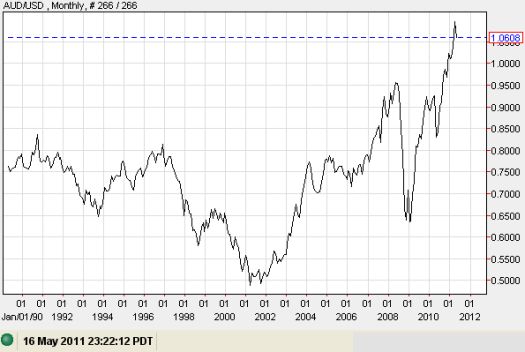The Reserve Bank of Australia (RBA) released its minutes from its last board meeting, May 3. I reviewed these minutes curious to understand the bank’s expectations for commodity prices given the on-going sell-off in commodities. The meeting occurred just as commodities started their current sell-off, so these pressures were not salient at the time. However, the RBA does expect “above trend growth” over the next few years that will continue to deliver inflationary pressures, requiring the RBA to continue pushing interest rates up.
The Reserve Bank of Australia recognizes that accomodative and easy money policies are helping to push commodity prices higher (emphasis mine):
“While the depreciation of the US dollar was one factor behind the increases, prices had also risen significantly in terms of other currencies, largely reflecting strong growth in demand, especially from the emerging economies. Members noted that monetary policy remained accommodative in most countries, which was adding to pressure on commodity markets. In this environment, global inflation risks appeared to have moved to the upside. In some countries, higher commodity prices were also acting as a negative supply shock and reducing real incomes at a time when activity remained quite subdued.”
Australia’s overall economy should continue to perform exceptionally well.
“Australia’s terms of trade were expected to rise by around 10 per cent over the March and June quarters, to be more than double their average level in the 1990s, before falling back a little over the forecast period as additional global supply of resources came on line…
…Recent data confirmed above-trend growth in the world economy, which was boosting commodity prices. In turn, this was supporting real incomes in Australia and leading to very high levels of investment in the resources sector. The outlook for economic activity remained largely unchanged. While there were many uncertainties about the world economic outlook, the central scenario was for a continuation of above-trend growth. Growth in Australia was expected to be relatively strong over the next few years, with the unemployment rate moving lower.”
Central banks are clearly believers in Australia. I was quite surprised to see the RBA identify demand from central banks as a source of upward pressure for the Aussie dollar. Diversification away from the U.S. dollar is taking many, many forms!
“…the Australian dollar had tended to rise more than most other currencies. An important influence had been purchases by other central banks seeking to invest their official reserve assets.”
Australia shows its commitment to higher rates by recognizing that certain sectors of the economy may suffer. The RBA feels that higher rates will help the economy overall:
“Members noted that the significant divergences between different sectors of the economy presented challenges for policy-making, but that monetary policy had to be set for the needs of the overall economy. In this respect, members judged that if economic conditions continued to evolve as expected, higher interest rates were likely to be required at some point if inflation was to remain consistent with the medium-term target. Members agreed to continue to assess carefully the evolving outlook for growth and inflation at future meetings.”
Overall, the outlook for the Australian dollar remains very strong. The current swoon in commodities may drag the currency into a notable correction, but such a move will represent another great buying opportunity.

Source: dailyfx.com charts
Be careful out there!
Full disclosure: long FXA, long AUD/JPY
